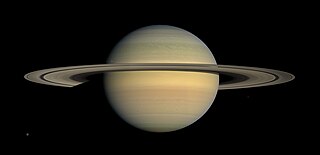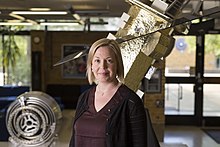
Jupiter is the fifth planet from the Sun and the largest in the Solar System. It is a gas giant with a mass more than two and a half times that of all the other planets in the Solar System combined, and slightly less than one one-thousandth the mass of the Sun. Jupiter orbits the Sun at a distance of 5.20 AU (778.5 Gm) with an orbital period of 11.86 years. Jupiter is the third brightest natural object in the Earth's night sky after the Moon and Venus, and it has been observed since prehistoric times. It was named after Jupiter, the chief deity of ancient Roman religion.

Saturn is the sixth planet from the Sun and the second-largest in the Solar System, after Jupiter. It is a gas giant with an average radius of about nine-and-a-half times that of Earth. It has only one-eighth the average density of Earth, but is over 95 times more massive.

Cassini–Huygens, commonly called Cassini, was a space-research mission by NASA, the European Space Agency (ESA), and the Italian Space Agency (ASI) to send a space probe to study the planet Saturn and its system, including its rings and natural satellites. The Flagship-class robotic spacecraft comprised both NASA's Cassini space probe and ESA's Huygens lander, which landed on Saturn's largest moon, Titan. Cassini was the fourth space probe to visit Saturn and the first to enter its orbit, where it stayed from 2004 to 2017. The two craft took their names from the astronomers Giovanni Cassini and Christiaan Huygens.

Himalia, or Jupiter VI, is the largest irregular satellite of Jupiter, with a diameter of at least 140 km (90 mi). It is the sixth largest Jovian satellite, after the four Galilean moons and Amalthea. It was discovered by Charles Dillon Perrine at the Lick Observatory on 3 December 1904 and is named after the nymph Himalia, who bore three sons of Zeus. It is one of the largest planetary moons in the Solar System not imaged in detail, and the third largest not imaged in detail within the orbit of Neptune.

The magnetosphere of Saturn is the cavity created in the flow of the solar wind by the planet's internally generated magnetic field. Discovered in 1979 by the Pioneer 11 spacecraft, Saturn's magnetosphere is the second largest of any planet in the Solar System after Jupiter. The magnetopause, the boundary between Saturn's magnetosphere and the solar wind, is located at a distance of about 20 Saturn radii from the planet's center, while its magnetotail stretches hundreds of Saturn radii behind it.

The magnetosphere of Jupiter is the cavity created in the solar wind by Jupiter's magnetic field. Extending up to seven million kilometers in the Sun's direction and almost to the orbit of Saturn in the opposite direction, Jupiter's magnetosphere is the largest and most powerful of any planetary magnetosphere in the Solar System, and by volume the largest known continuous structure in the Solar System after the heliosphere. Wider and flatter than the Earth's magnetosphere, Jupiter's is stronger by an order of magnitude, while its magnetic moment is roughly 18,000 times larger. The existence of Jupiter's magnetic field was first inferred from observations of radio emissions at the end of the 1950s and was directly observed by the Pioneer 10 spacecraft in 1973.

Jan Charles "John" Zarnecki, is an English space science professor and researcher. Since 2013, Zarnecki has been a Director of the International Space Science Institute. Between 2004 and 2013 he was a Professor of Space Science at the Open University, having previously been a professor and researcher at the University of Kent.

Discovery and exploration of the Solar System is observation, visitation, and increase in knowledge and understanding of Earth's "cosmic neighborhood". This includes the Sun, Earth and the Moon, the major planets Mercury, Venus, Mars, Jupiter, Saturn, Uranus, and Neptune, their satellites, as well as smaller bodies including comets, asteroids, and dust.

Michele Karen Dougherty is a Professor of Space Physics at Imperial College London. She is leading unmanned exploratory missions to Saturn and Jupiter and is Principal Investigator for J-MAG – a magnetometer for the European Space Agency's Jupiter Icy Moons Explorer, due for launch in April 2023.

David John Southwood is a British space scientist who holds the post of Senior Research Investigator at Imperial College London. He was the President of the Royal Astronomical Society from 2012–2014, and earlier served as the Director of Science and Robotic Exploration at the European Space Agency (2001–2011). Southwood's research interests have been in solar–terrestrial physics and planetary science, particularly magnetospheres. He built the magnetic field instrument for the Cassini Saturn orbiter.

Margaret Galland Kivelson is an American space physicist, planetary scientist, and distinguished professor emerita of space physics at the University of California, Los Angeles. From 2010 to the present, concurrent with her appointment at UCLA, Kivelson has been a research scientist and scholar at the University of Michigan. Her primary research interests include the magnetospheres of Earth, Jupiter, and Saturn.

The Cassini space probe was deliberately disposed of via a controlled fall into Saturn's atmosphere on September 15, 2017, ending its nearly two-decade-long mission. This method was chosen to prevent biological contamination of any of the moons of Saturn now thought to offer potentially habitable environments. Factors that influenced the mission end method included the amount of rocket fuel left, the health of the spacecraft, and funding for operations on Earth.

Athena Coustenis is an astrophysicist specializing in planetology. Dr. Coustenis, a French national, is director of research, Centre national de la recherche scientifique, at LESIA, at the Paris Observatory, Meudon. She is involved in several space mission projects for the European Space Agency (ESA) and for NASA. Her focus is on gas giant planets Saturn, Jupiter and their moons, and she is considered a foremost expert on Saturn's moon Titan.
The following outline is provided as an overview of and topical guide to Saturn:

Sheila Pearson is a British astronomer and the Education, Outreach and Diversity Officer at the Royal Astronomical Society.

Suzanne Mary Imber is a British planetary scientist specialising in space weather at the University of Leicester. She was the winner of the 2017 BBC Two television programme Astronauts, Do You Have What It Takes?.

Stanley William Herbert Cowley is a British physicist, emeritus Professor of Solar Planetary Physics at the University of Leicester.
Michelle F. Thomsen is space physicist known for her research on the magnetospheres of Earth, Jupiter, and Saturn.
Caitriona Jackman is an Irish space physicist. In 2021, she became the first female senior professor at the Dublin Institute for Advanced Studies (DIAS) Dunsink Observatory. She has made important contributions to understanding the solar wind interactions with planetary magnetospheres.
















